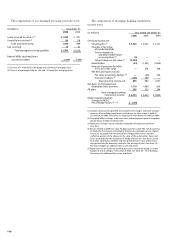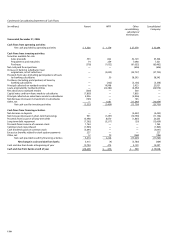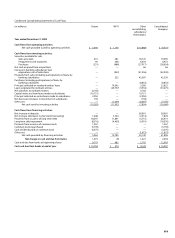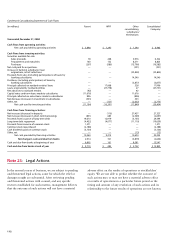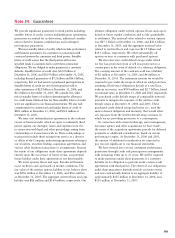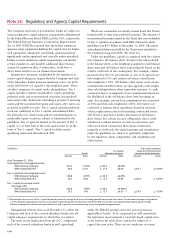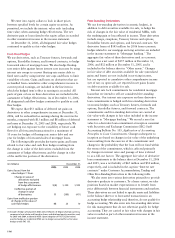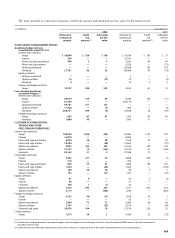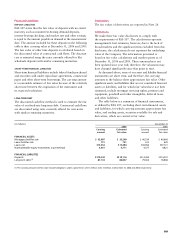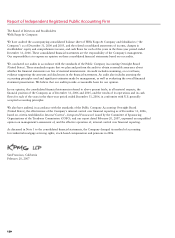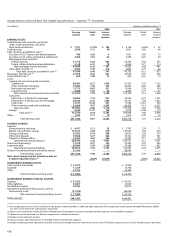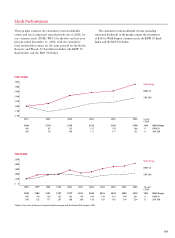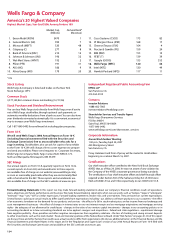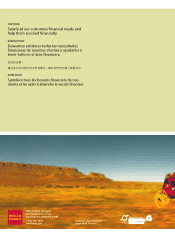Wells Fargo 2006 Annual Report Download - page 118
Download and view the complete annual report
Please find page 118 of the 2006 Wells Fargo annual report below. You can navigate through the pages in the report by either clicking on the pages listed below, or by using the keyword search tool below to find specific information within the annual report.
116
We enter into equity collars to lock in share prices
between specified levels for certain equity securities. As
permitted, we include the intrinsic value only (excluding
time value) when assessing hedge effectiveness. The net
derivative gain or loss related to the equity collars is recorded
in other noninterest income in the income statement.
At December 31, 2006, all designated fair value hedges
continued to qualify as fair value hedges.
Cash Flow Hedges
We use derivatives, such as Treasury futures, forwards and
options, Eurodollar futures, and forward contracts, to hedge
forecasted sales of mortgage loans. We also hedge floating-
rate senior debt against future interest rate increases by using
interest rate swaps to convert floating-rate senior debt to
fixed rates and by using interest rate caps and floors to limit
variability of rates. Gains and losses on derivatives that are
reclassified from cumulative other comprehensive income to
current period earnings, are included in the line item in
which the hedged item’s effect in earnings is recorded. All
parts of gain or loss on these derivatives are included in the
assessment of hedge effectiveness. As of December 31, 2006,
all designated cash flow hedges continued to qualify as cash
flow hedges.
We expect that $53 million of deferred net gains on
derivatives in other comprehensive income at December 31,
2006, will be reclassified as earnings during the next twelve
months, compared with $13 million and $8 million of deferred
net losses at December 31, 2005 and 2004, respectively. We
are hedging our exposure to the variability of future cash
flows for all forecasted transactions for a maximum of
10 years for hedges of floating-rate senior debt and one
year for hedges of forecasted sales of mortgage loans.
The following table provides derivative gains and losses
related to fair value and cash flow hedges resulting from
the change in value of the derivatives excluded from the
assessment of hedge effectiveness and the change in value
of the ineffective portion of the derivatives.
(in millions) December 31,
2006 2005 2004
Gains (losses) from fair
value hedges (1) from:
Change in value of
derivatives excluded
from the assessment
of hedge effectiveness $ (5) $ 350 $ 933
Ineffective portion of
change in value
of derivatives 11 (399) (411)
Gains from ineffective portion
of change in the value of
cash flow hedges 45 23 10
(1) Includes hedges of long-term debt and certificates of deposit, foreign currency,
commercial real estate and franchise loans, and debt and equity securities, and,
for 2005 and 2004, residential MSRs. Upon adoption of FAS 156, derivatives
used to hedge our residential MSRs are no longer accounted for as fair value
hedges under FAS 133.
Free-Standing Derivatives
We use free-standing derivatives (economic hedges), in
addition to debt securities available for sale, to hedge the
risk of changes in the fair value of residential MSRs, with
the resulting gain or loss reflected in income. These derivatives
include swaps, swaptions, Treasury futures and options,
Eurodollar futures and options, and forward contracts. Net
derivative losses of $145 million for 2006 from economic
hedges related to our mortgage servicing activities are included
in the income statement in “Mortgage banking.” The
aggregate fair value of these derivatives used as economic
hedges was a net asset of $157 million at December 31,
2006, and $32 million at December 31, 2005, and is
included in the balance sheet in “Other assets.” Changes
in fair value of debt securities available for sale (unrealized
gains and losses) are not included in servicing income,
but are reported in cumulative other comprehensive income
(net of tax) or, upon sale, are reported in net gains (losses)
on debt securities available for sale.
Interest rate lock commitments for residential mortgage
loans that we intend to sell are considered free-standing
derivatives. Our interest rate exposure on these derivative
loan commitments is hedged with free-standing derivatives
(economic hedges) such as Treasury futures, forwards and
options, Eurodollar futures, and forward contracts. The
commitments and free-standing derivatives are carried at
fair value with changes in fair value included in the income
statement in “Mortgage banking.” We record a zero fair
value for a derivative loan commitment at inception consistent
with Securities and Exchange Commission (SEC) Staff
Accounting Bulletin No. 105, Application of Accounting
Principles to Loan Commitments. Changes subsequent to
inception are based on changes in fair value of the underlying
loan resulting from the exercise of the commitment and
changes in the probability that the loan will not fund within
the terms of the commitment, which is affected primarily
by changes in interest rates and passage of time (referred
to as a fall-out factor). The aggregate fair value of derivative
loan commitments in the balance sheet at December 31, 2006
and 2005, was a net liability of $65 million and $54 million,
respectively, and is included in the caption “Interest rate
contracts” under Customer Accommodation, Trading and
Other Free-Standing Derivatives in the following table.
We also enter into various derivatives primarily to provide
derivative products to customers. To a lesser extent, we take
positions based on market expectations or to benefit from
price differentials between financial instruments and markets.
These derivatives are not linked to specific assets and liabilities
in the balance sheet or to forecasted transactions in an
accounting hedge relationship and, therefore, do not qualify for
hedge accounting. We also enter into free-standing derivatives
for risk management that do not otherwise qualify for hedge
accounting. They are carried at fair value with changes in fair
value recorded as part of other noninterest income in the
income statement.


